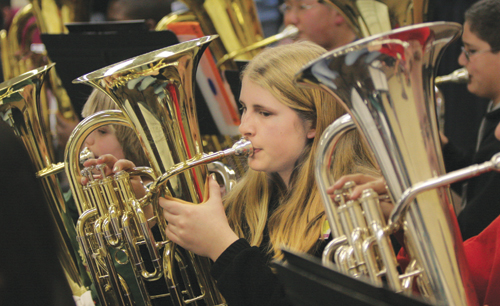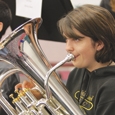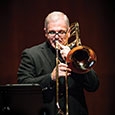
Although memories of beginning band have become cloudier with each passing year, I can still remember the process of trying out instruments during the first few weeks of school. I joined band wanting to be a trombone player and was happy when the director said that it might be a good fit for me. She also suggested that I might do well on baritone or tuba.
I had some idea of what a tuba was, but I had never heard of a baritone and was even more confused when I saw one. Here was an instrument that played in the same range as the trombone and used a similar mouthpiece, but it had valves instead of a slide. I tried playing baritone and sounded good on it, but I did not understand why it existed or what its role in the band was. When the director agreed to let me start on trombone instead, I felt relieved.
Years later when I started university studies as a music education major, I began doubling on this instrument, which the professors there called the euphonium. It was at this time that I first learned the characteristic timbre of this instrument, as well as its important place in the concert band sound.
Judging from the sounds I hear from high school euphonium players, the confusion I initially experienced with this instrument is not uncommon. Even students who have advanced technical skills often fail to produce the beautiful characteristic sound of the euphonium. These students often have no idea that this characteristic sound is even possible, and without any such concept, they do not know how to begin achieving this sound.
To address these areas of confusion, this article briefly considers how to develop the correct sound concept for the euphonium, how to achieve that sound with the right technique and equipment, and how this timbre fits in the concert band’s tonal palette.
Sound Concept
The most important step toward producing the characteristic timbre on any instrument is to start with a correct mental concept of the instrument’s sound. Developing a good concept of euphonium sound is sometimes hindered by a tendency of beginning and intermediate bands to pair the euphonium section with the trombones (which happens because these instruments often double each other’s parts). As a result of this approach, many beginning euphonium students conceive of their instrument’s sound as akin to that of the trombone. The sound that results from this concept is often a timbre that is somewhat darker than a trombone sound, but the sound is not the warm and rich sound desired from the euphonium.
This tendency to mimic trombone sound can be corrected by teaching students to think of the euphonium as a tenor tuba. The tuba represents an appropriate sound concept for the euphonium because, after all, the euphonium is the tenor member of the tuba family. To develop the tuba sound concept, euphonium students should be taught from an early age to listen to the tubas and to emulate that type of sound, rather than trying to sound like the trombones. To further promote this concept, it may also help to seat the euphonium and tuba sections next to each other.
Recordings of great euphonium players also are valuable in helping students develop a good sound concept. These recordings give students useful models of the correct euphonium sound.
Blowing Technique
Although a correct sound concept is the most important part of achieving the desired euphonium timbre, there are also technical and equipment-related steps that should be taken. The technical step is a subtle difference in the airstream. Whereas the trumpet and trombone should be blown in a way that is very direct and energetic, blowing on the euphonium should be more relaxed and expansive. Point out to euphonium students that most of the tubing on their instruments gets progressively bigger through the length of the instrument, and ask them to visualize blowing in a way that is similarly expansive.
I sometimes tell students to imagine that the entire ceiling is a mirror that needs to be fogged up when they play. This illustration helps students to understand that their blowing should be big but not excessively forceful, and this simple mental concept often yields great improvement in very short order.
Mouthpiece
The most common equipment-related impediment to developing a characteristic euphonium sound is poor mouthpiece choice. Because trombones and euphoniums share common mouthpiece receiver sizes, it is often wrongly assumed that a mouthpiece that works well on one will work equally well on the other. This tends to result in young euphonium players being given mouthpieces that are appropriate for beginning trombonists but too shallow to yield the best result on the euphonium.
A mouthpiece with a narrow diameter but a relatively deep cup, such as the Schilke 46D, can help even first-year euphonium players begin to cultivate a dark sound while still using a rim size that is appropriate for beginners. As students become more advanced, this pattern of using euphonium mouthpieces that have deeper and fuller cups than trombone mouthpieces should continue, because this will facilitate the desired tenor tuba timbre. The Schilke 51D and 52E2 have long been standard choices for this purpose, although a number of makers have introduced mouthpieces expressly designed for the euphonium. Two such mouthpiece lines are the Denis Wick SM series and the BB series from DEG, both of which were developed in collaboration with well-known euphonium virtuosi (Steven Mead and Brian Bowman, respectively).
The Euphonium’s Role in the Band
Although sometimes misconceived as just a slightly modified extension of the trombone section, the warm and rich timbre of the euphonium brings a darker color to the concert band palette. This timbre is more like that of the tubas than of the trombones, and yet in the hands of a skilled player it will become more than that. To grasp this, one needs only to hear a beautifully played euphonium countermelody in a march, with flowing slurred lines often soaring into the upper register. The euphonium’s cello-like voice is vitally important, and it is unlike that of any other instrument in the band.
By cultivating a characteristic sound concept, teaching correct blowing, and helping students to choose an appropriate mouthpiece, directors can help their euphonium students pursue this beautiful sound from day one.






